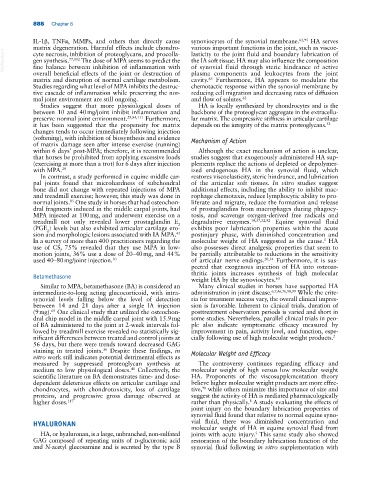Page 922 - Adams and Stashak's Lameness in Horses, 7th Edition
P. 922
888 Chapter 8
IL‐1β, TNFα, MMPs, and others that directly cause synoviocytes of the synovial membrane. 63,95 HA serves
matrix degeneration. Harmful effects include chondro- various important functions in the joint, such as viscoe-
VetBooks.ir gen synthesis. 77,112 The dose of MPA seems to predict the the IA soft tissue. HA may also influence the composition
lasticity to the joint fluid and boundary lubrication of
cyte necrosis, inhibition of proteoglycans, and procolla-
of synovial fluid through steric hindrance of active
fine balance between inhibition of inflammation with
overall beneficial effects of the joint or destruction of plasma components and leukocytes from the joint
matrix and disruption of normal cartilage metabolism. cavity. Furthermore, HA appears to modulate the
63
Studies regarding what level of MPA inhibits the destruc- chemotactic response within the synovial membrane by
tive cascade of inflammation while preserving the nor- reducing cell migration and decreasing rates of diffusion
mal joint environment are still ongoing. and flow of solutes. 62
Studies suggest that more physiological doses of HA is locally synthesized by chondrocytes and is the
between 10 and 40 mg/joint inhibit inflammation and backbone of the proteoglycan aggregate in the extracellu-
preserve normal joint environment. 29,84,111 Furthermore, lar matrix. The compressive stiffness in articular cartilage
it has been suggested that the propensity for matrix depends on the integrity of the matrix proteoglycans. 52
changes tends to occur immediately following injection
(softening), with inhibition of biosynthesis and evidence Mechanism of Action
of matrix damage seen after intense exercise (running)
within 6 days’ post‐MPA; therefore, it is recommended Although the exact mechanism of action is unclear,
that horses be prohibited from applying excessive loads studies suggest that exogenously administered HA sup-
(exercising at more than a trot) for 6 days after injection plements replace the actions of depleted or depolymer-
with MPA. 29 ized endogenous HA in the synovial fluid, which
In contrast, a study performed in equine middle car- restores viscoelasticity, steric hindrance, and lubrication
pal joints found that microhardness of subchondral of the articular soft tissues. In vitro studies suggest
bone did not change with repeated injections of MPA additional effects, including the ability to inhibit mac-
and treadmill exercise; however, this study was done in rophage chemotaxis, reduce lymphocytic ability to pro-
normal joints. One study in horses that had osteochon- liferate and migrate, reduce the formation and release
85
dral fragments induced in the middle carpal joints, had of prostaglandins from macrophages during phagocy-
MPA injected at 100 mg, and underwent exercise on a tosis, and scavenge oxygen‐derived free radicals and
treadmill not only revealed lower prostaglandin E degradative enzymes. 10,37,52,92 Equine synovial fluid
(PGE ) levels but also exhibited articular cartilage ero- 2 exhibits poor lubrication properties within the acute
2
sion and morphologic lesions associated with IA MPA. postinjury phase, with diminished concentration and
43
In a survey of more than 400 practitioners regarding the molecular weight of HA suggested as the cause. HA
5
use of CS, 75% revealed that they use MPA in low‐ also possesses direct analgesic properties that seem to
motion joints, 36% use a dose of 20–40 mg, and 44% be partially attributable to reductions in the sensitivity
used 40–80 mg/joint injection. 30 of articular nerve endings. 20,54 Furthermore, it is sus-
pected that exogenous injection of HA into osteoar-
thritic joints increases synthesis of high molecular
Betamethasone
weight HA by the synoviocytes. 63
Similar to MPA, betamethasone (BA) is considered an Many clinical studies in horses have supported HA
intermediate‐to‐long acting glucocorticoid, with intra- administration in joint disease. 6,7,46,76,98,99 While the crite-
synovial levels falling below the level of detection ria for treatment success vary, the overall clinical impres-
between 14 and 21 days after a single IA injection sion is favorable. Inherent to clinical trials, duration of
(9 mg). One clinical study that utilized the osteochon- posttreatment observation periods is varied and short in
69
dral chip model in the middle carpal joint with 15.9 mg some studies. Nevertheless, parallel clinical trials in peo-
of BA administered to the joint at 2‐week intervals fol- ple also indicate symptomatic efficacy measured by
lowed by treadmill exercise revealed no statistically sig- improvement in pain, activity level, and function, espe-
nificant differences between treated and control joints at cially following use of high molecular weight products. 2
56 days, but there were trends toward decreased GAG
staining in treated joints. Despite these findings, in Molecular Weight and Efficacy
36
vitro work still indicates potential detrimental effects as
measured by suppressed proteoglycan synthesis at The controversy continues regarding efficacy and
41
medium to low physiological doses. Collectively, the molecular weight of high versus low molecular weight
scientific literature on BA demonstrates time‐ and dose‐ HA. Proponents of the viscosupplementation theory
dependent deleterious effects on articular cartilage and believe higher molecular weight products are more effec-
chondrocytes, with chondrotoxicity, loss of cartilage tive, while others minimize this importance of size and
90
proteins, and progressive gross damage observed at suggest the activity of HA is mediated pharmacologically
higher doses. 117 rather than physically. A study evaluating the effects of
8
joint injury on the boundary lubrication properties of
synovial fluid found that relative to normal equine syno-
HYALURONAN vial fluid, there was diminished concentration and
molecular weight of HA in equine synovial fluid from
HA, or hyaluronan, is a large, unbranched, non‐sulfated joints with acute injury. This same study also showed
5
GAG composed of repeating units of d‐glucuronic acid restoration of the boundary lubrication function of the
and N‐acetyl glucosamine and is secreted by the type B synovial fluid following in vitro supplementation with

